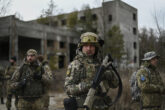March 15, 2017
Combatant Commands in an era of multi-domain battle
The U.S. military is currently adapting to a new era of conflict. Senior military leaders, including Army Chief of Staff Gen. Mark Milley, have focused heavily on improving readiness, and Deputy Secretary of Defense Bob Work has led the charge in developing the capabilities and recruiting the personnel necessary to maintain an advantage during rapid change. The multi-domain battle concept articulates future combined arms operations. In doing so, it prepares forces for the increased jointness required to achieve effects across multiple domains, including new ones such as cyber. Doctrinal innovation also often galvanizes organizational innovation. The philosophical underpinnings of multi-domain battle should be used to design a new combatant command structure.
Advanced technology is rapidly changing the operating environment. Technology breaks down traditional barriers and extends range: cyberattacks and electronic warfare have physical impact. Previously unchallenged domains, such as air, are now vulnerable to short-range threats from the ground, as well as advanced anti-access/area denial equipment. Multi-domain battle creates opportunity in one domain using the capabilities of others, including nontraditional domains such as cyber and space. The vision has been embraced by Pacific Command Commander Adm. Harry Harris, who has sought to operationalize its interdisciplinary and creative thinking.
By coordinating cross-domain capabilities against a clearly defined problem set, Pacific Command demonstrates how the U.S. military should fight in the future. Through a mission-oriented combatant command structure, the U.S. military can apply this thinking more broadly.
Read the full article at Defense News.
More from CNAS
-
Defense / Transatlantic Security
When Defense Becomes Destruction: Austria-Hungary’s Mistake and Ukraine’s RiskThis article was originally posted on War on the Rocks. The southeastern Polish city of Przemyśl, with its elegant 19th century Habsburg-era train station, remains one of the ...
By Franz-Stefan Gady
-
Defense / Transatlantic Security
Ukraine’s Catch-22 MomentThis article was originally published in the Financial Times. In Joseph Heller’s wartime classic, Catch-22, the protagonist Yossarian seeks out the US army surgeon Doc Daneeka...
By Franz-Stefan Gady
-
CNAS Insights | Budgetary Own Goals Undermine “Speed and Volume”
On November 7, Secretary of Defense Pete Hegseth laid out a plan to overhaul the Department of Defense’s (DOD’s) acquisition system. Placing an emphasis on delivering new capa...
By Philip Sheers, Carlton Haelig & Stacie Pettyjohn
-
Drones: Who Is Making the New Weapons of War?
From Ukraine and Russia to Gaza and Sudan, drones have become a key weapon of war. Which companies are making them, and profiting from this rapidly expanding but controversial...
By Stacie Pettyjohn




